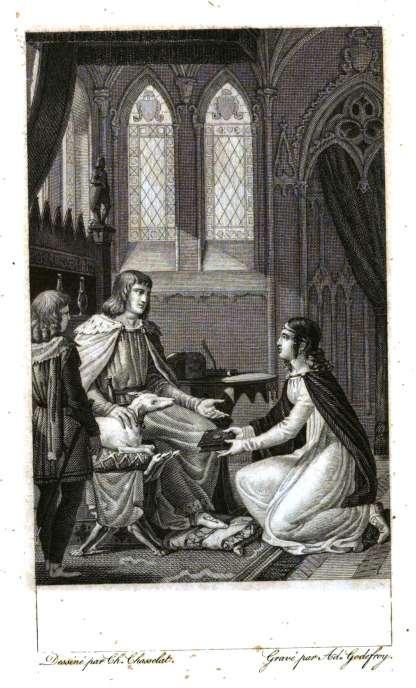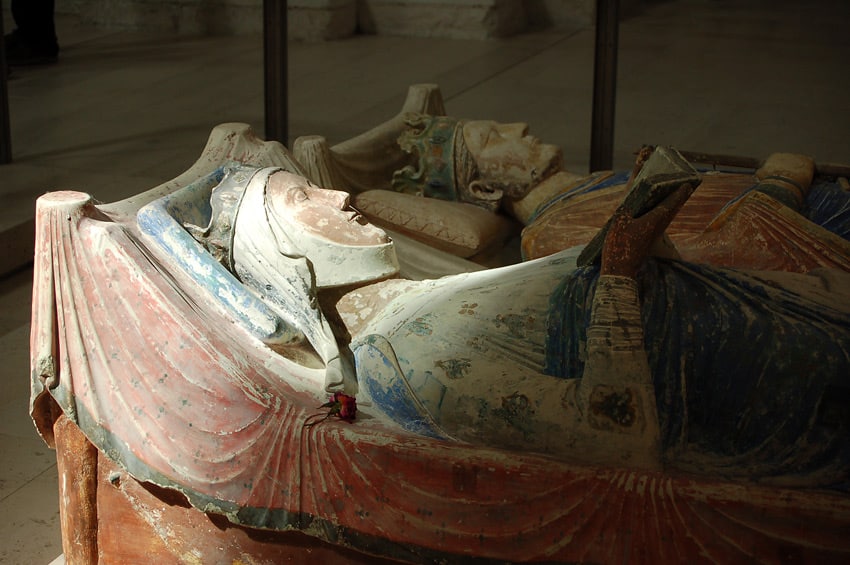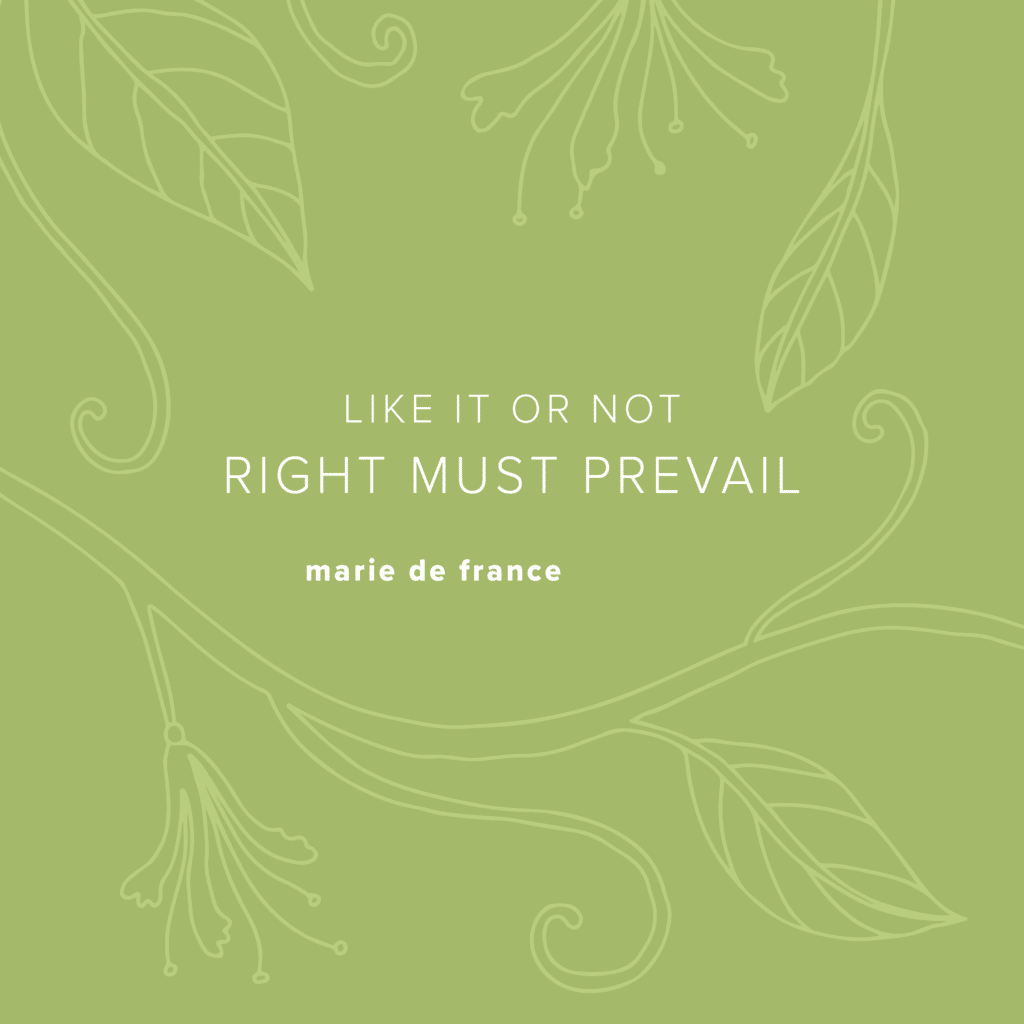Today we’re bringing you another woman writer from Medieval times for December’s installment of our Somebodies series: MARIE DE FRANCE. Like Hrotsvitha from a couple weeks ago, Marie de France broke ground as one of the first female writers of influence during this time. Though virtually nothing is known of her life, she is considered to be the first woman to write in French verse and is also a scholar and translator of note. Along the way, we’ll briefly highlight two other interesting women who may have been connected to Marie de France.

(source: Wikipedia)
It is clear from her writing that Marie de France was multilingual, meaning she must have had a great education for women in her time period! Because of this, she is believed to have either been a nun or a noblewoman, but the actual name and identity of who we now know as Marie de France is unknown. She is known by this name because of a line from one of her works: “Marie ai num, si sui de France,” which translates as “My name is Marie, and I am from France.” There is much speculation as to who she was, however, and guesses range from the illegitimate half-sister to Henry II, King of England, to various abesses and other more minor women of nobility. She is known to have written around 1160 to 1215, and, from her writings, scholars have gathered that, although born in France and writing in Francien, a French dialect, she spent most of her life in England. The most popular surmise is that the “noble king” to whom she dedicated her most prominent works was King Henry II of England, regardless of if she was related to him or not.

(source: Wikipedia)
If Marie de France did indeed dedicate her poems to Henry II, that means she may have been acquainted with his wife, another (very powerful) woman, Queen Eleanor of Aquitaine, who was known as a patron of the arts (including chivalric romances like Marie wrote). Like Marie de France, Eleanor also bridged the gap between France and England—she was married to the kings of both countries (Louis VII of France and Henry II). She also birthed two kings, the famous (or infamous) Richard the Lionheart and King John.

(source: Wikipedia)
Marie de France’s literary credits include four works, including the best-known Lais of Marie de France, a collection of twelve narrative poems in a style called Breton lais. She claims in her writing that she heard the stories contained in the collection from minstrels, and these writings follow the larger chivalric romance style popular during this time. In this genre, characters are largely motivated by romantic love, which, though praised, usually causes suffering and sorrow in the end. Like other writings of this kind, her stories are filled with adultery and lust, and many scholars have pointed out that her words seem to defy the morals and norms of the time, for lovers and also women.. Her heroines have agency, and she even wrote these words: “Amur n’est pruz se n’est egals,” which translates to “Love is not honorable, unless it is based on equality.” As with Hrotsvitha’s writings, to reduce Marie de France’s to an agenda or ideology doesn’t honor the complexity of her characters or the complexity of writing as a woman in a male-dominated society. Even so, it is cool to read the writings of another woman who was clearly thinking about woman’s place in society and in the world.
Sidenote: these poems were among the first works that made their way into Old Norse. The same king that hobnobbed with Snorri Sturluson also commissioned a work called Strengleikar, which is a collection of twenty-one tales. Many of them were based on Marie de France’s lais, and they became counted among the Old Norse chivalric sagas as well as the French chivalric tradition.

Marie de France is also credited with translating over one hundred of Aesop’s fables into French and also with retelling a legend about St. Patrick. Recently she has been attributed with writing a saint’s life called La Vie seinte Audree about Saint Audrey of Ely. Also known as Æthelthryth or Etheldreda, this saint is known for escaping her kingly kidnapper and evading capture (and evading her vows being desecrated) by the rising of the tide. Though not all scholars agree that Marie de France wrote this account, we’d like to think she did—it makes sense that a barrier-breaking woman would want to write about another one!
Today’s quotation comes one of her Breton lai poems, called Lanval. In typical chivalric fashion, this work tells a complicated love story. The action follows a knight in King Arthur’s court, named Lanval, who is wooed by a fairy lady and gets mixed up with Queen Guinevere’s courtly antics. Although Lanval ends up betraying his lover, she whisks him away to Avalon anyway. If this sounds like the plot of a Hallmark movie, you can think of these types of stories as the great great grandmothers of our cheesy rom coms today. Even so, this story contains truths within, such as…
“Like it or not, right must prevail.”
As for the artwork for today’s free wallpaper, this honeysuckle design was inspired by Marie de France’s other most popular poem, “Chevrefoil” (or “Honeysuckle”), which reads…
He could no longer live that way,
Cut off from the one he loved, for they
Were like the honeysuckle vine,
Which around a hazel tree will twine,
Holding the trunk as in a fist
And climbing until its tendrils twist
Around the top and hold it fast.
Together tree and vine will last.
But then, if anyone should pry
The vine away, they both will die.
‘My love, we’re like that vine and tree;
I’ll die without you, you without me.’
Cheesy? Yes. But relevant!

Don’t forget to check out our Instagram stories for our free smartphone wallpaper, or download below!













